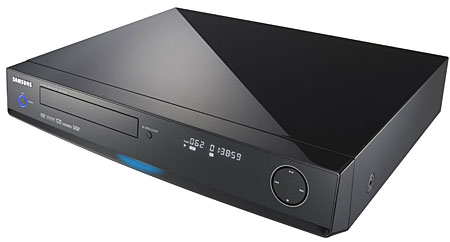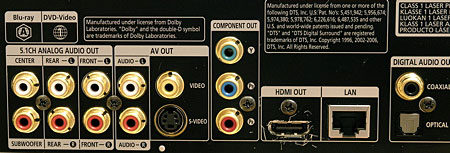Samsung BD-P1200 Blu-ray Player

With the BD-P1200, Samsung enters Blu-ray, The Next Generation, with a smartly styled, less expensive machine. But it's getting harder to keep up with this stuff. Shortly before I finished this report, word arrived that two new Samsung players would be launched in the fall: the BD-P1400 ($549, September) and the BD-P2400 ($649, October, Silicon Optix' HQV video processing).
That might appear to render this report moot. But the BD-P1200 is available now and at $649 it's competitive with Sony's new, slightly cheaper BDP-S300. The Samsung should also be available at significantly discounted prices, either soon or when the new players become available.
I anticipate that the basic feature set of the new players will be very similar to this one. As for performance, I would not be surprised to find that the BD-P2400, in particular, provides performance very similar to the BD-P1200. So you might look at this review a sneak peek at Samsung's new players—with the caveat that it will take an in-depth review of those third-generation models to confirm the accuracy of my crystal ball.
A Look Around
The high gloss front panel of the BD-P1200 has all the controls and indicators you'll need for basic operations, including an Output Select button to choose which video output will be active. The back panel has all your outputs: component and HDMI, legacy composite and S-Video, TosLink optical and coaxial SPDIF, and 2- and 5.1-channel analog audio. There's an exhaust port for the fan and a non-detachable power cord. There's also an Ethernet (LAN) terminal, useful for downloading the inevitable (if past experience holds) firmware updates. The excellent owner's manual includes detailed firmware upgrade instructions. (The firmware in the reviewed sample is the most recent: 0705 19.01 111f 0924.04 xaa.)
The BD-P1200 will play Blu-ray Discs encoded with any of the current video codecs: MPEG-2, VC-1, or AVC. It will also play standard DVDs, Audio CDs, and discs that carry MP3 audio and/or JPEG images. It will not play HD DVDs, Blu-ray 1.0 rewritable (RE) discs, SACD, DVD-Audio, CD Video, some types of recordable CDs and DVDs, or discs encoded with an incompatible region code.
The Samsung has two features that are not yet widespread on disc players: HDMI 1.3 and Silicon Optix' HQV processing (the latter courtesy of the REON chip set). HDMI 1.3, in theory, provides support for advanced video features (Deep Color and x.v.Color) that are not yet available from any prerecorded source material. We're just starting to see x.v.Color in some HD camcorders. I could not test any of the player's HDMI 1.3 video features, as I lack sources that can make use of them.
HDMI 1.3's audio features, however, are another matter. HDMI 1.3 is specified to pass both of the new lossless audio formats, Dolby TrueHD and DTS HD Master Audio, as native bitstreams to an AV receiver or pre-pro that can decode them. This is important because no Blu-ray player yet available will transcode DTS-HD Master Audio into multichannel PCM (which can be passed along by earlier versions of HDMI). And many Blu-ray players, including this Samsung, will not internally decode or transcode Dolby TrueHD either.

There have been conflicting reports on the ability of early HDMI 1.3 chips to pass along these two new audio formats in their native bitstream form. Until this week, however, we lacked the HDMI 1.3-capable AV receiver we needed to verify that function in an HDMI 1.3 player. But we have just received the Onkyo TX-SR875, the first AV receiver to come our way with both HDMI 1.3 and the ability to decode both of these new audio formats. Rather than delay this report until we can set it up and familiarize ourselves with the Onkyo's operation, however, I will post a follow up in this space just as soon as possible to let you know if the Samsung will pass these formats directly to a receiver.
For this report I made do with conventional Dolby Digital and DTS tracks or, if available, the uncompressed PCM multichannel soundtracks now available on many Blu-ray Discs. These uncompressed tracks can be passed to your AV receiver or pre-pro either over HDMI, or from the player's 5.1-channel analog output.
I used the HDMI connection for most of my testing, except where noted otherwise. The Samsung's 5.1-channel analog output provides a single 100Hz crossover to the subwoofer (if selected) and no distance setup for the individual channels to provide the optimum delays. And while there's a test tone, there are no individual channel level adjustments, either. In other words, the Samsung's 5.1-channel output offers a below average set of features. I didn't use it, except to check its basic sound quality using music through the front L/R channels only.
The HQV REON is a highly regarded video processor used here not only for upconversion of standard definition discs to 480p, 720p, 1080i, or 1080p on HDMI, but also for scaling and/or deinterlacing those few Blu-ray Discs (mostly music videos) mastered at 1080i to 1080p to match the capabilities of 1080p displays.
























































